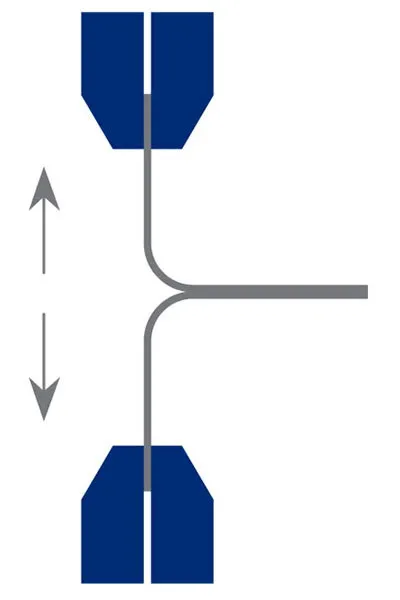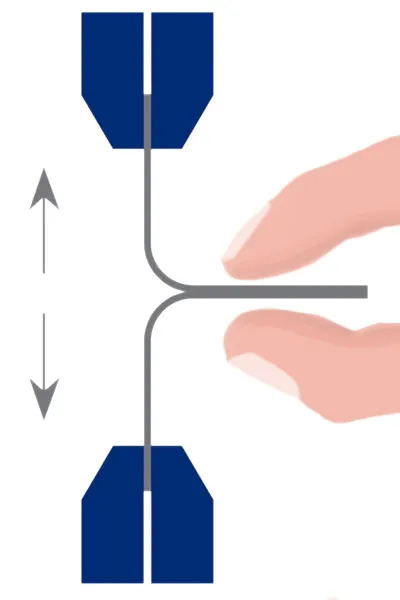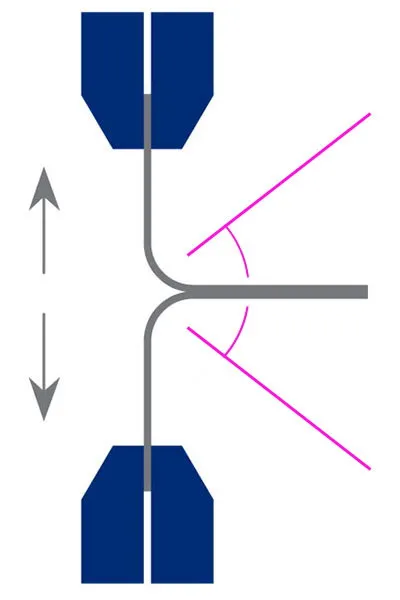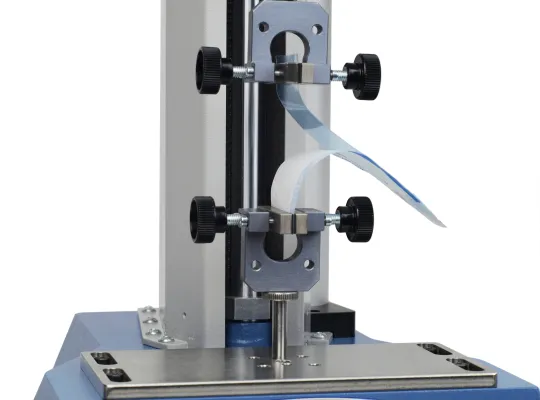Search results
Standards
Featured or equivalent test standards for Mecmesin solutions in this section
Term Video
Test summary
Specimens are cut to a specified width. The seal is then peeled apart by holding the two “legs” of the barrier material in the jaws of a force testing stand set to separate at a constant speed between 200 - 300 mm/min. while the force and displacement are continuously measured. The peak force required to separate the seal is reported, this can also be expressed as peak force per width of the seal material in N/m. Depending upon the characteristics of the specimen, it may also be informative to report the average peeling force over the width of the seal as it separates, discarding the first 10% and the last 10% of the force Vs displacement curve.
Test apparatus
Tensile tester with grips and suitable range loadcell. This may be a vertical testing stand, or alternatively a horizontally oriented instrument
Preparation
Cut a sufficient quantity of strips from a representative sample to a width of 15 mm, 25 mm or 25.4 mm perpendicular to the seal, and 75mm plus the width of the seal in length. If required, condition the specimens in accordance with ASTM E 171
Test method
1. If required, condition the samples as per ASTM E 171.
2. Cut strips from the sample to the dimensions defined in the standard.
3. Clamp the ends of the sample strip into the jaws of the tensile tester with the seal perpendicular to the direction of movement, and equidistant between the fixed and moving jaws.
4. If required, support the tail of the test specimen (see the standard for an explanation).
5. Set the tensile tester in motion at a speed between 200 and 300 mm/min.
6. Record the tensile force and displacement as the seal is peeled apart.
Report
Record all details necessary to identify the sample including width and machine direction in relation to the direction of pull.
Report the speed of separation used by the tensile tester, and the method used to support the tail of the sample if appropriate.
Report the maximum tensile force in newtons encountered as the specimen is stressed to failure. This can also be expressed as force per unit width of the seal in newtons per metre.
Note the method of failure of the seal.
Depending upon the characteristics of the force Vs displacement curve, it may be informative to calculate the average force as the seal is separated, discarding the first and final 10% of the force Vs displacement curve.




Laminierte Auto-Windschutzscheiben-Perimeterdichtungs-Schältests
Laminierte Auto-Windschutzscheiben-Perimeterdichtungs-Schältests
Der MultiTest 1-i wurde erworben, um die physikalischen Eigenschaften von Rohstoffen und Fertigprodukten zu testen. Die 10N-Wägezelle kann bis auf zwei Dezimalstellen messen, was einen sehr empfindlichen und genauen Messwert ergibt. Dieser Test funktioniert sehr gut. Der MultiTest 1-i erfüllt unsere Anforderungen und hat sich mit der Zeit als benutzerfreundlich erwiesen.
Adriana Jamesova,
Salze Gesundheitswesen

Um den britischen Standard in Bezug auf die Heißsiegelfestigkeit von medizinischen Beuteln zu erfüllen, stellte Mecmesin ein bedienerfreundliches System zur Verfügung, das Daten in grafischer Form anzeigt, um die Einhaltung des Standards eindeutig nachzuweisen.
David Dixon, Qualitätssicherungstechniker
Rocket Medical Plc


Online Prüfgeräte Vorführungen
Da immer mehr Menschen von zu Hause aus arbeiten, führen unsere technischen Verkaufsingenieure gerne Vorführungen und Schulungen über einen webbasierenden Videoanruf durch.
Bitte senden Sie uns, wenn möglich Muster zu, sodass unser Verkaufsteam in der Lage ist Ihnen die Tests an Ihren eigenen Produkten vorzuführen.
Bitte kontaktieren Sie uns, damit wir Ihre Anforderungen besprechen können und einen Vorführtermin oder eine Schulung vereinbaren können.







